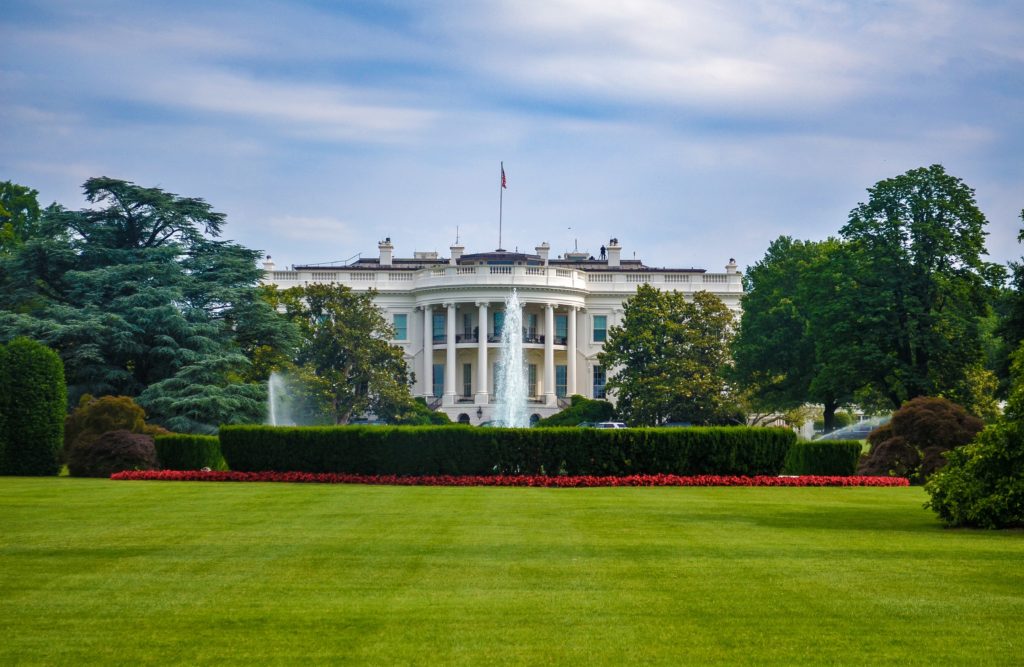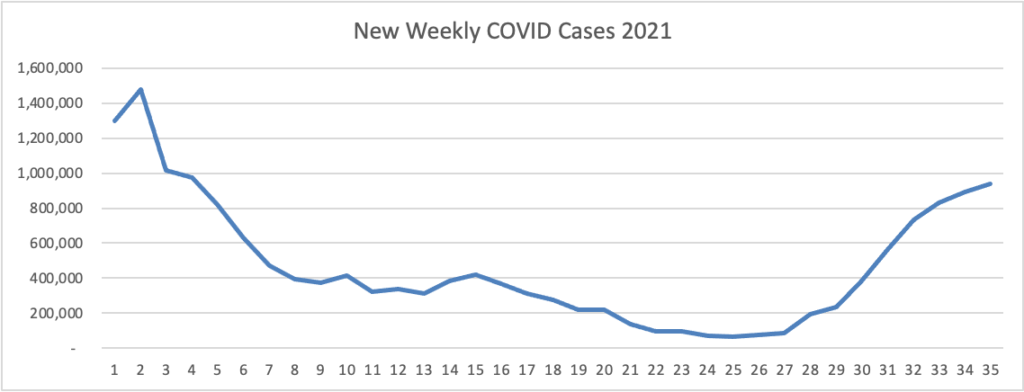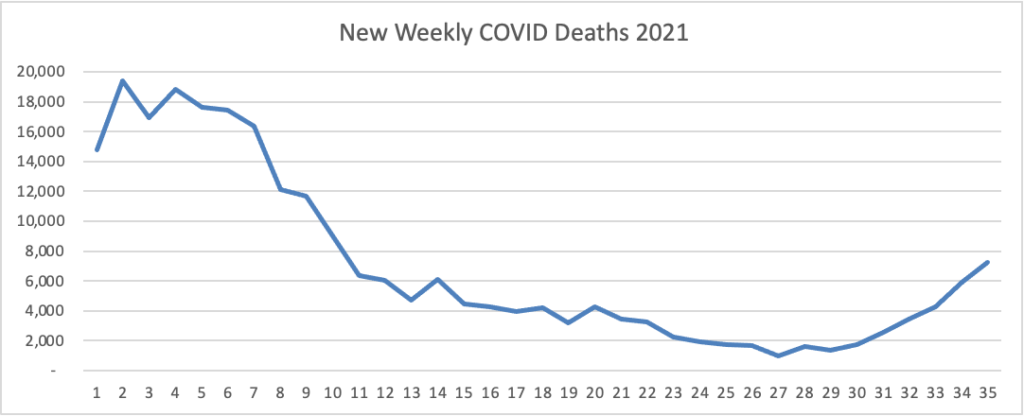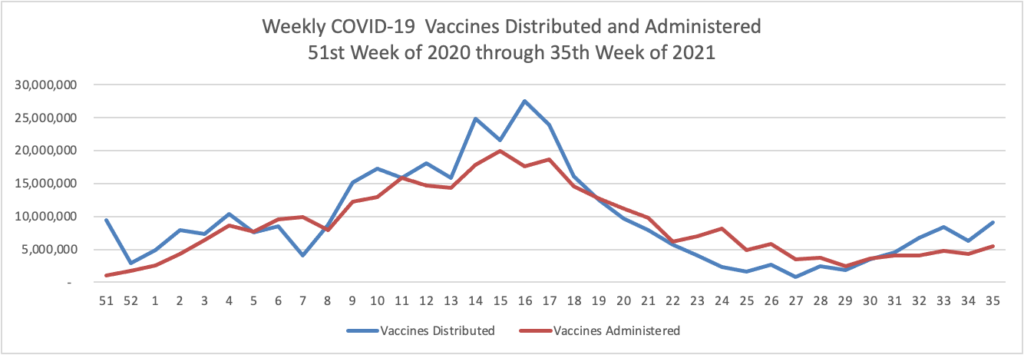Thursday Miscellany
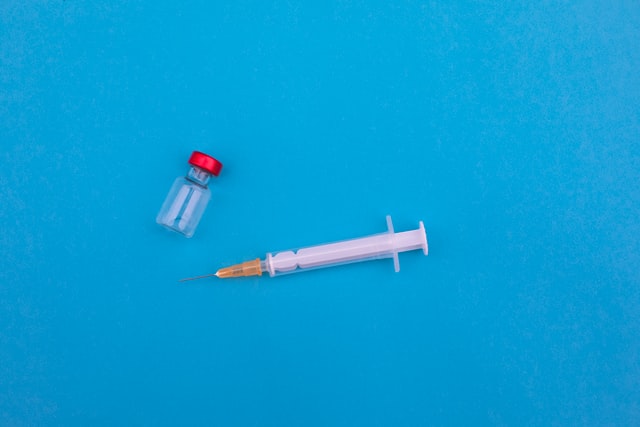
From the Delta variant vaccine front, The American Hospital Association informs us that
- The Centers for Medicare & Medicaid Services today issued an interim final rule requiring COVID-19 vaccinations for workers in most health care settings, including hospitals and health systems, that participate in the Medicare and Medicaid programs. The rule is effective Nov. 5. Under the regulation, all eligible workers must be fully vaccinated by Jan. 4, 2022.
- Also this morning, the Occupational Safety and Health Administration (“OSHA”) issued an emergency temporary standard requiring all employees at private businesses with 100 or more workers to be vaccinated by Jan. 4 or get tested for COVID-19 weekly.
The Society for Human Resource Management (SHRM) provides us with SHRM’s Top Takeaways from the OSHA ETS:
- Employees must be fully vaccinated by January 4, 2022, and employers must require unvaccinated employees to mask and produce a negative test on at least a weekly basis.
- Employers are required to have a written vaccination policy.
- The OSHA ETS does not apply to employees who do not report to a workplace where there are other individuals such as coworkers or customers are present; employees working from home; or employees who work exclusively outdoors.
- The OSHA ETS does not require employers to provide or pay for tests.
- Employers must pay employees for the time it takes to get vaccinated.
- Employers must ensure all unvaccinated employees are masked.
- Employers must report COVID-19 fatalities and hospitalizations to OSHA.
- The OSHA ETS reaffirms that employers must provide reasonable accommodations.
- According to the Department of Laborvaccine, testing and face-covering requirements preempt inconsistent state and local requirements.
Closer to home, the OSHA ETC does not apply to workplaces subject to EO 14042 on Requiring Coronavirus Disease 2019 Vaccination for Federal Contractors. However, Govexec points out that
“Under the [Occupational Safety and Health Act], the U.S. Postal Service is treated as a private employer,” said OSHA’s emergency temporary standard, set to officially publish in the Federal Register on Friday. “It is therefore required to comply with this [emergency temporary standard] in the same manner as any other employer covered by the act.”
The [Labor Department] spokesperson added that there are about 500,000 postal workers and confirmed that the rule applies to all of them.
Federal New Networks adds that
The Biden administration on Thursday pushed back the deadline for federal contractors to comply with its vaccine mandate.
Contractors now have until Jan. 4, 2022, the same deadline the White House set for private sector companies with 100 employees or more to comply with vaccine and testing requirements from the Labor Department’s Occupational Safety and Health Administration. * * *
The White House said it will not apply the OHSA emergency temporary standard or the CMS rule to workplaces subject to the federal vaccine mandate for contractors, so employers won’t have to track multiple requirements.
While federal contractors now have the same Jan. 4 deadline as other private sector companies, there’s a key difference between the two policies.
Under the new OSHA standard, companies with 100 employees or more have to ensure their workers have received either one or both shots by Jan. 4 — or tests for COVID-19 at least weekly.
Under the federal vaccine mandate for contractors, employees don’t have the option to be tested weekly, at least not at this point.
Govexec reports that “The Office of Personnel Management on Wednesday reminded agencies that they must grant federal employees administrative leave to accompany their children to get the COVID-19 vaccine, following the news that more children are now able to get vaccinated.” It would be helpful if OPM gave direct guidance to FEHB carriers on the contractor vaccine mandate.
From the Delta variant front, STAT News reports that
Britain granted conditional authorization on Thursday to the first pill shown to successfully treat Covid-19 so far. It also is the first country to OK the treatment from drug maker Merck, although it wasn’t immediately clear how quickly the pill would be available.
The pill was licensed for adults 18 and older who have tested positive for Covid-19 and have at least one risk factor for developing severe disease, such as obesity or heart disease. Patients with mild-to-moderate Covid-19 would take four pills of the drug, known molnupiravir, twice a day for five days.
An antiviral pill that reduces symptoms and speeds recovery could prove groundbreaking, easing caseloads on hospitals and helping to curb outbreaks in poorer countries with fragile health systems. It would also bolster the two-pronged approach to the pandemic: treatment, by way of medication, and prevention, primarily through vaccinations.
Molnupiravir is also pending review with regulators in the U.S., the European Union, and elsewhere. The U.S. Food and Drug Administration announced last month it would convene a panel of independent experts to scrutinize the pill’s safety and effectiveness in late November.
From the preventive care front —
The Associated Press informs us that
A government advisory committee on Wednesday recommended that all U.S. adults younger than 60 be vaccinated against hepatitis B, because progress against the liver-damaging disease has stalled.
The decision means that tens of millions of U.S. adults — mostly between the ages of 30 and 59 — would be advised to get shots. Hepatitis B vaccinations became standard for children in 1991, meaning most adults younger that 30 already are protected.
“We’re losing ground. We cannot eliminate hepatitis B in the U.S. without a new approach,” said Dr. Mark Weng of the Centers for Disease Control and Prevention.
The Advisory Committee on Immunization Practices voted unanimously to approve the recommendation Wednesday. The CDC’s director, Dr. Rochelle Walensky, must sign off on it before it becomes public policy, but it’s not clear when she will decide.
The American Cancer Society tells us about the proper use of lung screenings to detect cancer in this Lung Cancer Awareness Month.
The Robert Woods Johnson Foundation has updated its report on the state of childhood obesity in our country.
From the healthcare business front —
Fierce Healthcare reports that
Cigna wrapped up third-quarter earnings for major national payers Thursday morning, where it reported $1.6 billion in profit for the quarter.
The results surpassed Wall Street expectations, according to Zacks Investment Research. Cigna also brought in $44.3 billion in revenue in the third quarter, according to the earnings report, which also beat analysts’ projections.
Both figures were up significantly year over year, Cigna said. In the third quarter of 2020, the insurer earned $1.4 billion in profit and brought in $41 billion in revenue. * * *
Due to the results, Cigna raised its guidance and now expects $20.35 in earnings per share for 2021. The insurer expects full-year revenues of $172 billion.
Fierce Healthcare also catalogs “new [healthcare M&A] deals that were revealed, closed or called off during the month of October.
In that regard Beckers Payer Issues reports that
UnitedHealth Group and Change Healthcare entered into an amended agreement with the Justice Department not to finalize the healthcare companies’ proposed $13 billion deal until late February.
Four things to know:
1. Under the new timing arrangement, the companies agreed not to consummate their deal before Feb. 22, 2022, according to Change Healthcare’s Nov. 3 earnings report.
2. The new date amends a previous timing agreement announced in August, under which, UnitedHealth and Change agreed to wait at least 120 days after certifying compliance with the Justice Department’s request for more information. Both organizations had agreed to not certify compliance with the request before Sept. 15, meaning the 120 days would have expired in January 2022.
3. The organizations announced the proposed acquisition in January. Change shareholders approved the deal despite backlash from hospital groups arguing that the proposed combination is anticompetitive.
4. On March 24, the Justice Department issued a second information request to the organizations. In the Nov. 3 earnings report, Change Healthcare shared that it and UnitedHealth “certified substantial compliance” with the second request.
Also STAT News provides a “progress report on Big Retail’s ambitions in health care.” This point impressed the FEHBlog
[T]he physical assets of retail players stand to give them a substantial leg up in parts of the country not already saturated by startups and other rivals, including the Midwest and broad swaths of the South.
“Most people in America live close to some of these retail giants and not to a health care provider,” said Gadelrab, who visited a Walmart for the first time to get tested for Covid-19.
Even for retailers’ significantly buzzier rivals, such as hybrid care startups Carbon Healthand women’s care-focused Tia, physical locations have remained a core part of their business models amid the pandemic, pitting their offerings somewhat against the services offered by Walmart, in particular.
“For us, the physical experience has been around making preventive health something women want to engage in before something is wrong,” said Carolyn Witte, Tia’s co-founder and chief executive officer.
That physical proximity could prove especially useful, Gadelrab said, as parts of the U.S. health care system begin to shift away from a fee-for-service treatment model to one based on value-based or preventive care, since it could theoretically allow retail giants to keep more consistent tabs on patients, much in the same way popular telehealth tools check in regularly with their users. At the same time, retailers also maintain reams of data on consumer health and wellness spending, and more recently, vaccination status — information that could be used to better inform their health care offerings or reach more potential clients.







